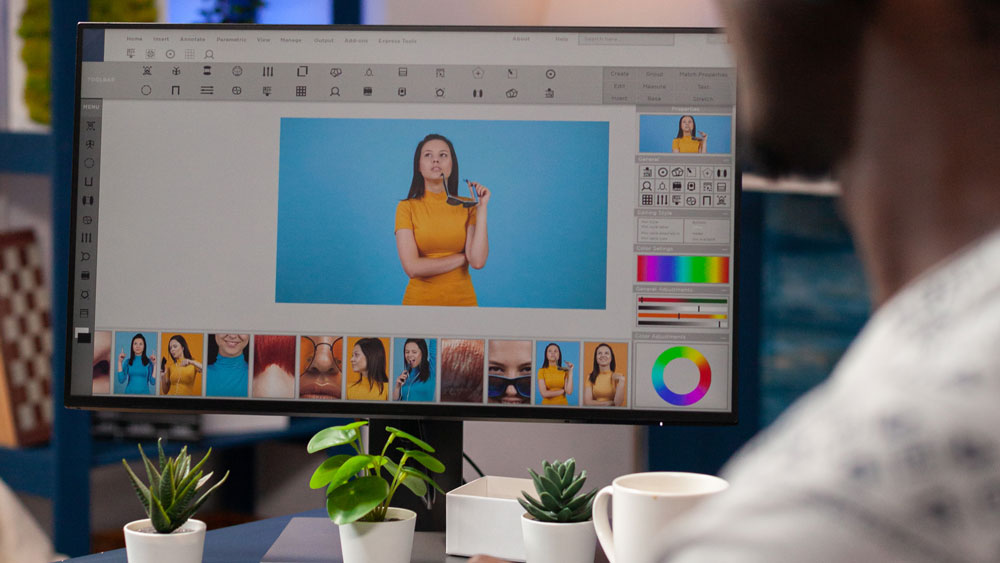Peter Huppertz
Peter Huppertz
Blog entry by Peter Huppertz
Selecting the right images for eLearning content can greatly enhance the learning experience. However, with various image styles available, it can be challenging to determine which type best suits your course. In this post, we'll explore different types of images commonly used in eLearning, their pros and cons, and best practices for using them effectively.
Types of Images for eLearning
1. Photos
Pros:
- Realism: Closely mirrors real-life situations, making it relatable.
- Emotion: Can convey strong emotions, enhancing engagement.
- Familiarity: Learners are accustomed to realistic images from movies and daily life.
Cons:
- Availability: Finding the right images that fit your specific scenarios can be challenging.
- Inclusivity: Ensuring cultural and demographic inclusiveness can be difficult; overly inclusive photos might seem artificial.
- Representation: Some learners might not feel represented in the images.
- Distraction: Details of the photo can distract learners.
- Stock Photos: Often look too polished and unrealistic.

2. Collages
Pros:
- Versatility: Easier to combine elements from various photos, providing a unique look.
- Style: Can create a stylish and distinctive aesthetic for your eLearning content.
Cons:
- Effort: Requires more work to cut out and arrange elements.
- Pose Issues: Finding the right poses for each element can still be challenging.

3. Drawing / Vector Style
Pros:
- Amendability: Abstract and easier to modify.
- Clarity: Can clearly depict specific situations by focusing on key elements.
Cons:
- Emotion: Less capable of conveying strong emotions.
- Identification: Learners may find it harder to identify with abstract images.
- Density: Less detailed and engaging compared to realistic images.

4. Silhouettes
Pros:
- Abstraction: Offers a high level of abstraction, suitable for representing diverse demographics.
- Simplicity: Simple and clear, minimizing distractions.
Cons:
- Emotion: No emotional engagement.
- Identification: Learners cannot identify with silhouettes, reducing personal connection.

5. Comic style
Pros:
- Uniqueness: Provides a unique and engaging style.
- Uniformity: Easy to create a consistent style using filters or AI tools.
- Abstract Identification: The abstraction can make it easier for learners to identify with characters.
Cons:
- Perception: Might be seen as childish, potentially undermining serious content.
- Source Images: Still requires finding the right source images for consistency.

6. 3D images
Pros:
- Poses: Allows for any pose or scenario.
- Uniformity: Ensures a consistent style throughout the content.
- Versatility: Can be used for both images and video sequences.
Cons:
- Polish: Can appear too polished or artificial.
- Perception: Might be seen as cold and impersonal.
- Quality: Requires high-quality production to be convincing.
- Skills: Needs proficiency with 3D software for creation.
- Complexity: Dense scenes can be complex to produce.

Best Practices for Using Images in eLearning
- Balance Realism and Abstraction: Choose the type of image that best suits the content and learning objectives. Realistic images are great for relatable scenarios, while vector and silhouette images are better for abstract concepts.
- Ensure Inclusivity: Strive for inclusivity in a natural and authentic way. Avoid tokenism by representing a wide range of demographics genuinely.
- Match the Tone: Align the image style with the course tone. Comics might be great for light-hearted content, while 3D and realistic images suit more serious topics.
- Minimize Distractions: Ensure that images support the learning content rather than distract from it. Avoid overly detailed or busy images.
- Quality Over Quantity: Use fewer, high-quality images rather than many low-quality ones. Quality visuals can significantly enhance the learner's experience.
Conclusion
Choosing the right type of image for your eLearning course involves weighing the pros and cons of each style and considering the specific needs of your learners and content. By understanding the strengths and limitations of each image type, you can make informed decisions that enhance engagement and learning outcomes.
What types of images do you use in your eLearning courses? Share your experiences, best practices, and any challenges you've encountered in the comments below!
Key Points
- Different image types (realistic, collage, vector, silhouettes, comic, 3D) offer unique benefits and challenges.
- Best practices include balancing realism and abstraction, ensuring inclusivity, matching the course tone, minimizing distractions, and prioritizing quality.
